Meerut
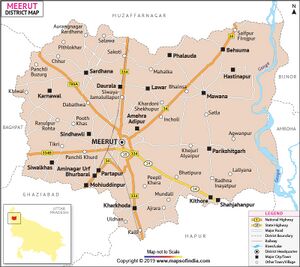
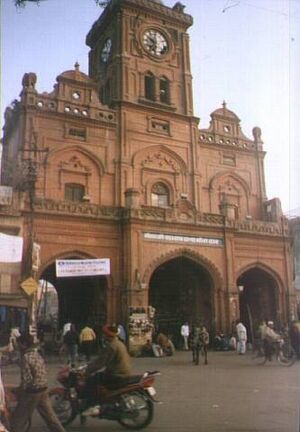
Meerut (मेरठ), (Urdu: میرٹھ) is a city, district headquarters and a municipal corporation in Meerut district in Uttar Pradesh.
Variants of name
- Mayarashtra (मयराष्ट्र) = Meerut (मेरठ) (AS, (p.711)
- Maya Rashtra (मयराष्ट्र) = Meerut (मेरठ) (AS, (p.711)
- Meerut मेरठ, उ.,प्र., (AS, p.758)
Location
It is an ancient city located 72 km (44 miles) north-east of New Delhi. Meerut also has one of the major Indian army garrisons/ cantonments in this part of the country.
Jat Gotras in Meerut district
Bamel, Bana, Barach, Dhaka, Dhankhar, Dharan, Gared, Galiyan, Ghanghas, Gulia, Jakhar, Jatain, Johiya, Kakran, Kaler, Kaliraman, Kalkal, Kashnay, Khare, Khatras, Khatri, Naga, Ohlan, Punia, Panghal, Poras, Rangi Raghuvansi, Rathi, Rana, Saharan, Sangwan, Sehrawat, Sindhu, Siwach, Taliyan, Tomar, Vehan, dalal
Tahsils in Meerut district
Villages in Meerut Tahsil
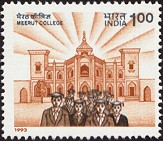
Aad, Afzalpur Pawati, Ahara, Ajnauli, Ajrara, Alamgir Pur, Alampur Buzurg, Allipur Jijmana, Amanullapur, Amehra Adipur, Aminagar urf Bhurbaral (CT), Amipur Nagola, Arnawali, Ataula, Atrara, Azampur, Badhala Kaithwara, Badholi, Badnoli, Bafar, Bahadarpur, Bahchaula, Bahrampur Khas, Bahrampur Morna, Bajaut, Banwaripur, Baram, Barhanpur, Basatikri, Bhadaura, Bhagwanpur, Bhagwanpur Chittawan, Bhagwanpur Khalsa, Bhavi, Bhawanpur, Bhurpur, Bijoli, Bohla, Chak Morna, Chandora, Chandsara, Chhajmalpur Urf Chhajupur, Chhattri, Chindori Khas, Chindori Patti Dalu, Chobla, Dadri, Dalampur, Damgarhi, Dastoi, Datavali Gesupur, Daulatpur Fakhrabad Urf Kayast, Dhadra, Dhanota, Dhilaura, Dhindala, Dhir Khera, Dilwara, Dimoli, डूंगर, Durjanpur, Faizabad Pachgaon, Fakharpur Kabatta, Fatehpur, Fatehpur Ambkhera, Gagaul, Gangheri, Gejha, Ghat, Govindpur, Govindpur Urf Ghasauli, Gyanpur, Hajipur, Hasanpur Qadim, Hasanpur Razapur, Idris Pur, Ikla, Incholi, Islamabad Chhilora, Itayira, Jalalpur, Jalaluddinpur Masoodpur Gawri, Jamalpur Majra, Jangethi, Jani Buzurg, Jani Khurd, Janjokhar, Jasora, Jasori, Jataula, Jatpura Meerut, Jithauli, Jogipura, Johra, Jurranpur, Kaili, Kaithwari, Kalanjari, Kalina, Kalyan Pur, Kamalpur, Kanauni, Kastala Shamshernagar, Kaul, Kazamabadgoon, Khajuri, Khandawali, Khanpur, Khanpur, Khardoni Shekhupur, Kharkhari, Kharkhauda, Kharkhoda (NP), Khaspur, Khawajahanpur, Khera Balrampur, Kheri Nizd Kalina, Kherki Muzakkipur, Khwajampur Majra, Kinannagar, Kishori, Kitholi, Kudhla, Kunkura, Kurali, Kuri, Ladpura, Laharra, Lahaurgarh, Mahroli, Mamipur, Mansabgarh, Masoori, Mau Khas, Medpur, Meerut (CB), Meerut (M Corp.), Mehpa, Mirpur, Mirpur Jakhera, Mirzapur, Mirzapur, Mohd.Pur Gumi, Mohdpur Dhumi, Mohiuddinpur (CT), Mohiuddinpur Lalsana, Morna, Mundali, Murlipur Phool, Muzaffarnagar Saini, Muzakkipur, Nagla Kaboolpur, Nagla Kumbha, Nagla Mal, Nagla Patu, Nagla Shekhu, Nangla Tashi, Nagli Azamabad, Nalpur, Nanu Fatahpur, Narahara, Narangpur , Nek, Pabla, Pachgaon Patti Amar Singh, Pachgaon Patti Sanwal, Pachpera, Panchi, Panchli Khurd, Pastra, Patti Kherki, Peepli Khera, Pepla, Puth Khas, Puthri, Raghunathpur, Rajpura, Rajpura, Rali Chauhan, Rampur Moti, Rasna Mohammadpur Akbarpur, Rasulpur Aurangabad, Rasulpur Dhantala, Rasulpur Dhaulri, Rasulpur Marhi, Rasulpur Rohta, Rasulpur Zahid, Rawa, Rukanpur, Ruknuddinpur Misri Urf Phaphun, Sadharanpur, Sadullapur Urf Chandpura, Salahpur, Salarpur Jalalpur, Saleh Nagar, Salempur, Sameypur, Sarawa, Satwai, Set Kuan, Sewalkhas(NP), Shafiabad Loti, Shahpur Jainpur, Shakarpur, Shaulana, Shekhpuri, Shipura, Sial, Sikhera, Sikri, Sindhawali, Sisola Buzurg, Sisola Khurd, Sisoli, Siwal Khas, Soharka, Tatina Sani, Thirot, Tikri, Timakia, Ukasia, Ukhleena, Uldeypur, Uldhan, Uplehra,
Name Etymology
Ravana's wife Mandodari (in Ramayana) hailed from Meerut. The town may have derived its name from "Maya Rashtra", the capital of the kingdom owned by Mandodari's father Mayasura. Maya (मया) gotra Jats are found in Madhya Pradesh.
History
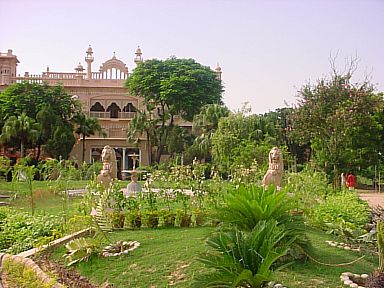
Meerut is famously associated with the Indian Revolution of 1857 against the British East India Company, when chants of popular Hindi slogan "Dilli Chalo" ("Let's march to Delhi!") were first raised here. Meerut cantonment is the place where the rebellion started when Hindu and Muslim soldiers were given rifle cartridges with a coating made of animal fat. The bullet wrapping was to be opened by mouth before use, which affected religious sensibilities of both Muslims and Hindus as the animal coating was alleged to be composed of pork and beef. Meerut leapt into international prominence during the revolution of 1857, when on 24 April, 1857, eighty-five troopers out of ninety of the third cavalry refused to touch the cartridges and after court martial, were sentenced to ten years imprisonment. This marked the beginning of a general movement of freedom from the British yoke, with the support of the civilian populace. Meerut is also famous in Indian history as one of the famous controversial case happened in India which is known as Meerut Conspiracy Case in the year 1929.
Sir H. M. Elliot Edited by John Dowson[1] writes quoting the Yamini which says that, in his Twelfth Expedition A.H. 409 (1018-1019 AD) after passing by the borders of Kashmir, that is, close under the sub-Himalayan range, and crossing the Jumna, Mahmud of Ghazni takes Baran, which is the ancient name of the present Bulandshahr for which more modern authors, not knowing what " Baran" was, substitute "Mirat" — then Kulchand's fort, which is the Mahaban of the other — then crossing the Jumna he takes Mathura — and then recrossing the Jumna, he proceeds to Kanauj, and takes that and its seven detached forts, of which the ruins of some may still be traced. He then goes to Munj, " a city of Brahmans."
First War of Independence 1857

First War of Independence 1857 began with a mutiny of sepoys of British East India Company's army on the 10th of May 1857, in the town of Meerut, and soon erupted into other mutinies and civilian rebellions largely in the upper Gangetic plain and central India, with the major hostilities confined to present-day Uttar Pradesh, Bihar, northern Madhya Pradesh, and the Delhi region. The rebellion posed a considerable threat to Company power in that region, and it was contained only with the fall of Gwalior on 20 June 1858. The rebellion is also known as India's First War of Independence, the Great Rebellion, the Indian Mutiny, the Revolt of 1857, and the Sepoy Mutiny.
At Meerut, a large military cantonment, 2,357 Indian sepoys and 2,038 British soldiers were stationed along with 12 British-manned guns. The station held one of the largest concentrations of British troops in India and this was later to be cited as evidence that the original rising was a spontaneous outbreak rather than a pre-planned plot.[2]
Although the state of unrest within the Bengal Army was well known, on 24 April Lieutenant Colonel George Carmichael-Smyth, the unsympathetic commanding officer of the 3rd Bengal Light Cavalry, ordered 90 of his men to parade and perform firing drills. All except five of the men on parade refused to accept their cartridges. On 9 May, the remaining 85 men were court martialled, and most were sentenced to 10 years' imprisonment with hard labour. Eleven comparatively young soldiers were given five years' imprisonment. The entire garrison was paraded and watched as the condemned men were stripped of their uniforms and placed in shackles. As they were marched off to jail, the condemned soldiers berated their comrades for failing to support them.
The next day was Sunday. Some Indian soldiers warned off-duty junior British officers that plans were afoot to release the imprisoned soldiers by force, but the senior officers to whom this was reported took no action. There was also unrest in the city of Meerut itself, with angry protests in the bazaar and some buildings being set on fire. In the evening, most British officers were preparing to attend church, while many of the British soldiers were off duty and had gone into canteens or into the bazaar in Meerut. The Indian troops, led by the 3rd Cavalry, broke into revolt. British junior officers who attempted to quell the first outbreaks were killed by the rebels. British officers' and civilians' quarters were attacked, and four civilian men, eight women and eight children were killed. Crowds in the bazaar attacked off-duty soldiers there. About 50 Indian civilians, some of them officers' servants who tried to defend or conceal their employers, were killed by the sepoys.[3] While the action of the sepoys in freeing their 85 imprisoned comrades appears to have been spontaneous, some civilian rioting in the city was reportedly encouraged by kotwal (local police commander) Dhan Singh Gurjar.[4]
Some sepoys (especially from the 11th Bengal Native Infantry) escorted trusted British officers and women and children to safety before joining the revolt.[5] Some officers and their families escaped to Rampur, where they found refuge with the Nawab.
The British historian Philip Mason notes that it was inevitable that most of the sepoys and sowars from Meerut should have made for Delhi on the night of 10 May. It was a strong walled city located only forty miles away, it was the ancient capital and present seat of the nominal Mughal Emperor and finally there were no British troops in garrison there in contrast to Meerut.[6] No effort was made to pursue them.
मेरठ
विजयेन्द्र कुमार माथुर[7] ने लेख किया है .... मेरठ (AS, p.758): उत्तर प्रदेश में स्थित है. इसका प्राचीन नाम मयराष्ट्र था. किंवदंती के अनुसार इस नगर को महाभारत काल में मयदानव ने बसाया था. मयदानव उस समय का महान शिल्पी था तथा इसी ने युधिष्ठिर के राजसूय यज्ञ में अद्भुत सभा भवन का निर्माण किया था. अर्जुन तथा कृष्ण ने खांडववन को जलाते समय यहां रहने वाले मयदानव की रक्षा करके उसे अपना मित्र बना लिया था. (देखिए आदिपर्व 233, सभा.1). संभवतः खांडव वन की स्थिति वर्तमान मेरठ के निकटवर्ती क्षेत्र में थी. जान पड़ता है कि वास्तव में खांडव वन दिल्ली के इंद्रप्रस्थ नामक स्थान के निकट (पुराने किले के आसपास) रहा होगा. क्योंकि पांडवों की राजधानी इंद्रप्रस्थ, इसी वन को जला डालने पर जो स्वच्छ भू-भाग प्राप्त हुआ था उसी में बसाई गई थी. किंतु यह भी संभव है कि यह वर्तमान दिल्ली से लेकर मेरठ तक के क्षेत्र में विस्तृत था.
11 वीं सदी में दौर क्षेत्रीय हरदत्त ने मेरठ को जीतकर यहां एक किला बनवाया जिसे कुतुबुद्दीन ने 1191 में जीत लिया. यहां एक बौद्ध मंदिर के भी अवशेष मिले थे. शाहपीर की दरगाह को नूरजहां ने बनवाया था. जामा मस्जिद, महमूद गजनी के वजीर हसन मेंहदी ने बनवाई थी (1019 ई.). इसकी मरमत हुमायूं ने करवाई थी.
खांडववन
विजयेन्द्र कुमार माथुर[8] ने लेख किया है कि....खांडवप्रस्थ के स्थान पर पांडवों की इंद्रप्रस्थ नामक नई राजधानी बनने के पश्चात अग्नि ने कृष्ण और अर्जुन की सहायता से खांडववन को भस्म कर दिया था. इसमें कुछ अनार्य जातियाँ जैसे नाग और दानव लोगों का निवास था जो पांडवों की नई राजधानी के लिए भय उपस्थित कर सकते थे. तक्षकनाग इसी वन में रहता था और यहीं मयदानव नामक महान यांत्रिक का निवास था जो बाद में पांडवों का मित्र बन गया और जिसने इंद्रप्रस्थ में युधिष्ठिर का अद्भुत सभा भवन बनाया. खांडववन-दाह का प्रसंग महाभारत आदि पर्व 221 से 226 में सविस्तर वर्णित है. कहा जाता है कि मयदानव का घर वर्तमान मेरठ (मयराष्ट्र) के निकट था और खांडववन का विस्तार मेरठ से दिल्ली तक, 45 मील के लगभग था. महाभारत में जलते हुए खांडववन का बड़ा ही रोमांचकारी वर्णन है. (आदि पर्व 224,35-36-37). खांडववन के जलते समय इंद्र ने उसकी रक्षा के लिए घोर वृष्टि की किन्तु अर्जुन और क़ृष्ण ने अपने शस्त्रास्त्रों की सहायता से उसे विफल कर दिया.
इतिहास
सहू गोत्र की एक छोटी सी सेना थी, जिसमें 80 घुड़सवार थे। सहू गोत्र के प्रमुख गढ़ हैं – धानसिया, दुरजाना, भाड़ंग (चुरू)[9]
भाड़ंग (चुरू) में इनके किले के खंडहर अभी भी मौजूद हैं। कहते है जब यह किला बनाया गया तब एक सारण गोत्र के जाट की बली दी गई थी। इस पर सारण और सहू लोगों में लड़ाई हुई जिसमें सारण विजई हुये। तब से सहू लोग गाँव छोडकर इधर-उधर चले गए। इनमे से कुछ बीबीपुर (जींद), मदनहेड़ी (हिसार) व रानीला (भिवानी) में बस गए। कुछ परिवार उत्तरप्रदेश के मेरठ जिले में आबाद हुये। कुछ मुसलमान बन गए जो अब शहीवाल पाकिस्तान में आबाद हैं। कुछ सिक्ख और बिश्नोई भी बन गए। [10]
जाट जागृति में योगदान
ठाकुर देशराज[11] ने लिखा है....खंडेलावाटी इलाके को जगाने के लिए.... जुलाई सन् 1931 में बधाला की ढाणी में जोकि पलसाना से 2 मील के फासले पर अवस्थित है। एक विद्यालय खोला गया जिसके प्रथम अध्यापक पंडित ताड़केश्वर जी शर्मा बनाए गए। उनके विद्यालय में मास्टर लालसिंह और बलवंतसिंह जी मेरठ वालों ने काम किया।
Archaeological Findings
इतिहासकार स्वामी ओमानन्द सरस्वती लिखते हैं
यौधेयों की पांचवें प्रकार की मुद्रायें जो कि यौधेय गण की अन्तिम मुद्रायें मानी जाती हैं, और प्रायः जिसे गण राज्यों अथवा उनकी मुद्राओं का स्वल्प ज्ञान रखने वाले व्यक्ति भी जानते हैं, उन पर ब्राह्मी लिपि तथा संस्कृत भाषा में "यौधेय गणस्य जय" लिखा है । मध्य में कार्त्तिकेय अपनी शक्ति लिये खड़ा है । उसके एक पग के पास मयूर (मोर) का चित्र चित्रित है । इस मुद्रा पर कार्त्तिकेय की शक्ति (भाला) और उसके शिर के बीच ब्राह्मी में "द्वि" लिखा है । इस मुद्रा पर दूसरी ओर चलती हुई देवी का चित्र है । देवी का बायां हाथ कटि पर स्थित है तथा दायां हाथ ऊपर उठा रखा है । हाथ में कंगन भी प्रतीत होते हैं । देवी के दायें हाथ के नीचे पुष्पों से परिपूरित पात्र (कलसा) भी विद्यमान है । देवी के बायें ओर इस प्रकार का चिह्न है । देखिये, द्वितीय फलक पर ५ संख्या (नम्बर) वाली मुद्रा । वर्तुलाकार इस में मुद्रा पर देवी के चारों ओर बनी मणियों की माला यह द्योतित करती है कि यह अमूल्य रत्नों तथा धन-धान्य से परिपूरित बहुधान्यक अर्थात् हरयाणा की मुद्रा है । यह यौधेयों की विजय की सूचना देने वाली मुद्रा है । सभी इतिहासज्ञों का यह विचार है कि कुषाणों को पराजित कर उखाड़ फेंक देने के पश्चात् यौधेय गण ने अपनी इस मुद्रा को ढाला (बनाया) था । यह मुद्रा प्रायः सम्पूर्ण हरयाणे में मिलती है । मेरठ, हापुड़, सुनेत, करौंथा, अटायल, आंवली, मोहनबाड़ी, हाँसी, हिसार, भिवानी, नौरंगाबाद, दादरी, मल्हाणा, सीदीपुर लोवा आदि स्थानों से यह मुद्रा हमें प्राप्त हुई है । महम, सोनीपत, जयजयवन्ती, सहारनपुर आदि अनेक स्थानों पर भी यह लोगों को पर्याप्त संख्या में मिली है ।[12]
Geography
Meerut is located at 28.98 N 77.7 E [13]. It has an average elevation of 219 metres .
Demographics
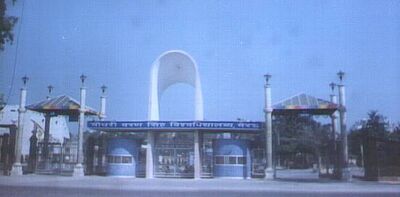
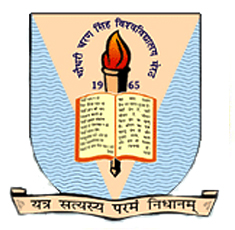
Meerut City is also the headquarters of Meerut district which consists of 1,025 villages with a population of around (3.44 million) according to the 1991 census. As of 2001 India census, Meerut had a population of 1,074,229. Males constitute 53% of the population and females 47%. Meerut has an average literacy rate of 58%, lower than the national average of 59.5%: male literacy is 64%, and female literacy is 52%. In Meerut, 14% of the population is under 6 years of age.
| District | Male | Female | Totals |
|---|---|---|---|
| Urban | 681,209 | 595,348 | 1,276,557 |
| Rural | 1,180,533 | 990,822 | 2,171,355 |
| Totals | 1,861,742 | 1,586,170 | 3,447,812 |
Meerut has one of the largest Muslim populations among the major cities of India(close to 45%). There is also a significant Christian population. Meerut was the site of one of India's worst communal riots during the 1980's.
Industry
Meerut City is famous for many types of industries. Meerut has seen a boom in the construction business as this city now has many buildings, shopping complexes and apartments. Meerut is the largest supplier of sports goods and also the largest manufacturer of musical instruments in India. It is also home to some prominent pharmaceuticals company of the region like Perk Pharmaceuticals Limited Perk Pharmaceuticals Limited, Mankind Pharma & Bestochem Pharma.
Jat Education Institutions
- Ch. Charan Singh University, Meerut [State University]
- Chhotu Ram Institute of Technology,CCS University Campus, Meerut
- Ch. Buddh Singh Memorial Kasimpur Kheri, Meerut, Uttar Pradesh,
- Jat College Mawana,
Notable Jats from Meerut district
- Ravi Kumar - Shooter
- Dr Hari Singh Nalwa - The founder and Editor-in-Chief of the Journal of Nanoscience and Nanotechnology. He is a Jat from Soop village of Meerut.
- Chitrangada Singh - Actress
- Raman Lamba (born on January 2, 1960 in Meerut, Uttar Pradesh) was an Indian cricket player.
- Hari Om Panwar - A famous poet from Meerut.
- Prithvi Singh Bedharak (चौधरी पृथ्वीसिंह बेधड़क) - A poet and folk-singer from village Shikopur (शिकोपुर) in Meerut district in Uttar Pradesh. He was born in Tanwar gotra Jat family.
- Praveen Kumar - Indian cricketer who has played One Day International cricket for his country and first-class cricket for Uttar Pradesh in India. He was born on 2 July 1986 in Meerut, Uttar Pradesh.
- Yuvika Chaudhary (Tomar) - is playing cameo in Shah Rukh Khan's latest movie Om Shanti Om where Deepika Padukone is playing lead actress role.
- Dhara Singh Sindhu(born:1896) (मास्टर धारासिंह सिंधु), from ----, Meerut, Uttar Pradesh, was a social worker in Nagaur, Rajasthan.[14]
- Mahendra Nath Shastri (born:1917) (चौधरी महेन्द्रनाथ शास्त्री), from ----, Meerut, Uttar Pradesh, was a social worker in Nagaur, Rajasthan.[15]
External Links
- Meerut at Wikipedia
- Official website of Meerut District
- Website of Choudhary Charan Singh University, Meetut
References
- ↑ The history of India : as told by its own historians. Volume II/Note D. — Mahmud's Expeditions to India,p.458
- ↑ Philip Mason, A Matter of Honour – an Account of the Indian Army, its Officers and Men, ISBN 0-333-41837-9, 278
- ↑ David, Saul (2003), The Indian Mutiny: 1857, London: Penguin Books, p. 528, ISBN 978-0-14-100554-6,p.93
- ↑ Hibbert, Christopher (1980), The Great Mutiny: India 1857, London: Allen Lane, p. 472, ISBN 978-0-14-004752-3,pp.8-85
- ↑ Sir John Kaye & G. B. Malleson: The Indian Mutiny of 1857, (Delhi: Rupa & Co.) reprint 2005, p. 49.
- ↑ Philip Mason, A Matter of Honour – an Account of the Indian Army, its Officers and Men, ISBN 0-333-41837-9,p. 278
- ↑ Aitihasik Sthanavali by Vijayendra Kumar Mathur, p.758
- ↑ Aitihasik Sthanavali by Vijayendra Kumar Mathur, p.256
- ↑ Dr. Jay Singh Sahu, Jat Samaj Agra, July 2015, p. 17
- ↑ Dr. Jay Singh Sahu, Jat Samaj Agra, July 2015, p. 17
- ↑ Thakur Deshraj:Jat Jan Sewak, 1949, p.444
- ↑ Veerbhoomi Haryana/यौधेय गण की मुद्रायें (पृष्ठ 140-142)
- ↑ Falling Rain Genomics, Inc - Meerut
- ↑ Thakur Deshraj:Jat Jan Sewak, 1949, p.189-190
- ↑ Thakur Deshraj:Jat Jan Sewak, 1949, p.199-200

